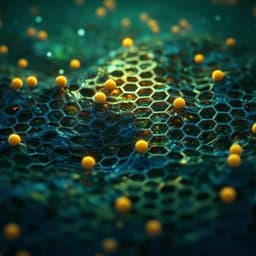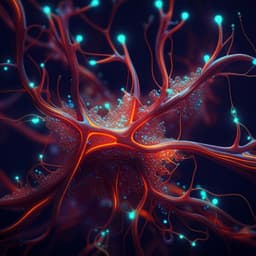
Engineering and Technology
Artificial organic afferent nerves enable closed-loop tactile feedback for intelligent robot
S. Chen, Z. Zhou, et al.
Discover the revolutionary artificial organic afferent nerve (AOAN) developed by Shuai Chen and colleagues, enabling intelligent robots to swiftly recognize and prevent slips using advanced tactile sensing. This innovation mimics synaptic behavior for enhanced neurorobotics and biomimetic electronics.
~3 min • Beginner • English
Introduction
The study addresses how to emulate human-like tactile sensing and processing in robotics by constructing artificial afferent nerves capable of low-power, event-driven operation, memory, and closed-loop feedback. Human tactile perception relies on mechanoreceptors (e.g., Merkel cells for sustained pressure and Ruffini corpuscles for directional stimuli) and synapses that convert spatiotemporal mechanical inputs into action potentials transmitted to the CNS, enabling adaptive responses such as slip prevention. Prior artificial mechanoreceptors often show volatile responses that decay rapidly, impeding downstream neuromorphic processing. Although neuromorphic computation using OFETs and von Neumann architectures has enabled tasks like Braille discrimination, they suffer from high write voltages, limited retention, and inefficiency compared to brain-like parallel processing. Organic electrochemical transistors (OECT/OEST), with mixed ionic/electronic transport, large transconductance, and sub-1 V operation, closely mimic neurotransmitter-mediated synaptic modulation via ion injection/extraction, but have rarely been integrated into parallel, event-driven artificial tactile systems with closed-loop actuation. The research goal is to realize a flexible artificial organic afferent nerve (AOAN) that integrates artificial mechanoreceptors with low-bias OESTs to perform tactile sensing, synaptic processing (short- and long-term plasticity), dendritic integration for spatiotemporal feature encoding, and closed-loop robotic slip detection and prevention.
Literature Review
Previous efforts include capacitive and piezoresistive touch sensors mimicking SA mechanoreceptors, which typically yield volatile signals. Software-level neuromorphic systems based on von Neumann architecture have demonstrated tactile discrimination and robotic control but face bottlenecks in parallel, low-power, in-memory processing. Hardware neuromorphic chips have emerged yet often rely on simulated action potentials and lack integration with event-driven sensory inputs. OFET-based sensory systems can encode external stimuli but generally require high operating biases (~10 V) and show limited state retention. Organic electrochemical transistors offer low-voltage operation (<1 V), large transconductance, and ionic/electronic coupling conducive to synaptic behaviors (e.g., EPSC analogs) but are frequently depletion-mode (power-consuming at rest) and have not been widely used to construct artificial afferent nerves for tactile processing, closed-loop control, or robust long-term plasticity. These gaps motivate the development of AOANs leveraging OESTs for sustainable, low-power, event-driven tactile sensing, processing, and feedback.
Methodology
- Device materials and design: An enhancement-mode organic electrochemical synaptic transistor (OEST) used an asymmetric regio-regular conjugated polymer channel, PFT-100, and a solid electrolyte (SE) comprising PVDF-co-HFP blended with ionic liquids EMIM[TFSI] or EMIM[OTF] at various mass ratios (ion blend 33–80%). A parylene-C insulating layer separated source/drain from the SE to minimize leakage. A PEDOT:PSS/Au gate served as a non-polarizable electrode. The AOAN was formed by integrating a piezoresistive touch sensor in series with the OEST gate, converting pressure-induced resistance changes into an effective gate bias that triggers ionic electrochemical doping in PFT-100.
- Fabrication: Source/drain Cr/Au electrodes were patterned on p-Si/SiO2 substrates. Parylene C layers were deposited for insulation and sacrificial peel-off. Patterned channel windows were defined via photolithography and RIE. PFT-100 (spin-coated from chloroform) formed the semiconductor channel. The polymer electrolyte (PVDF-co-HFP with EMIM[TFSI] or EMIM[OTF]) was spin-coated over the channel. Touch sensors were printed using a Voltera V-one on polyimide with silver ink electrodes and a spray-coated PEDOT:PSS sensing layer separated by a polyimide spacer.
- Electrical characterization: Transfer/output curves, leakage, and transconductance were measured at low V_D (−0.3 V) and V_G up to −0.6 to −0.8 V. Cyclic voltammetry assessed ion redox behavior. UV-Vis-NIR absorption tracked electrochemical doping. Transient responses, paired-pulse facilitation (PPF), post-tetanic potentiation (PTP), and relaxation times were characterized under pulsed gate biases and pressure pulses.
- AOAN operation tests: Pressure stimuli (0–50 kPa) were applied, mapping touch sensor resistance to effective gate bias and evaluating sensitivity, linear range, and memory retention. The role of ion type/blend ratio on conductance change and relaxation (τ) was quantified by exponential fits.
- Dendritic integration: Four mechanoreceptors were connected in parallel to one OEST to emulate spatially distributed inputs. Experiments compared single, synchronous, and asynchronous activation (Δt = 5 s) and sliding stimuli across the sensor array at varying speeds (action frequency up to 40 Hz).
- Robotic integration and closed-loop control: AOAN arrays were mounted on a robot finger/gripper. A metal ball performed controlled sliding (linear motor) and grip/slip scenarios. A closed-loop algorithm (Matlab R2022) detected slip via spike features and commanded regripping to prevent object drop.
- Deep learning: An LSTM-based RNN processed time-series signals from AOAN vs touch sensor-only datasets (900 samples across three classes: secure grip, slipping, slipping + regrip). Training (PyCharm/Python) evaluated classification accuracy and learning efficiency.
Key Findings
- Low-voltage, high-performance OEST: Enhancement-mode p-type operation at V_D = −0.3 V with low threshold (V_th ≈ −0.42 V) and high transconductance (g_m ≈ −1.86 mS) using 80% TFSI SE; on/off ratio ~3×10^6; leakage current <100 nA. CV showed lower redox potential for TFSI (−0.5 V) vs OTF (−0.9 V). Stable over 1000 gate-pulse cycles without significant conductance loss.
- Event-driven synaptic behavior and memory: OEST exhibited synaptic facilitation under pulsed inputs; integration with the touch sensor enabled event-driven activation by pressure. Relaxation times strongly depended on ion blend: τ ≈ 306.5 s (80% TFSI) vs 57.1 s (33% TFSI). Charge retention up to 4 h after a pressure spike, with ~0.3% synaptic weight retained. Standalone OEST transient response: τ ~234 ms (80% TFSI) with fast recovery (~12 ms) to off-state upon bias removal.
- Tactile sensing performance: AOAN sensitivity 106.8 kPa^-1 in the linear range 0–30 kPa; weak response at 50 kPa. Pressure-modulated transfer curves at low voltages (V_G = −0.6 V, V_D = −0.3 V). Synaptic weight increased with higher ion concentration, higher pressure (e.g., retention at 20 s rose from 8.1% at 6 kPa to 19.6% at 30 kPa), and lower stimulus frequency.
- Short-term and long-term plasticity: PPF and PTP depended on pulse parameters and ion blend. Example PPF indices at P = 10 kPa, t_p = 100 ms, Δt = 5 s: −255% (80% TFSI), 226% (50% TFSI), 104% (33% TFSI). PTP index (after 10 spikes): up to 2500% (80% TFSI) vs ~500% (33% TFSI). Memory level at 300 s increased with spike count and pressure; with 80% TFSI reached ~−126 μA vs ~−0.38 μA for 33% TFSI.
- Enhanced detection of subtle touch: Training-like facilitation enabled sensing of gentle, brief contacts (~2 kPa, ~100 ms) from a ping-pong ball bounce that the bare touch sensor could not resolve; responses increased with successive bounces before saturating due to full ionic doping.
- Dendritic integration and motion encoding: With four mechanoreceptors connected to one OEST, synchronous input yielded stronger postsynaptic response than single input, and asynchronous triggering (Δt = 5 s) produced even larger currents (~200 μA) than synchronous (~90 μA) due to cumulative PTP. Sliding stimuli across the array enabled rate and temporal coding; detectable action frequencies up to 40 Hz (v = 160 mm/s), covering Merkel disc sensitivity range (5–15 Hz). Trade-off observed: higher frequency decreased synaptic weight (shorter dwell) but increased PTP index.
- Closed-loop robotic slip control and AI decoding: AOAN-equipped gripper detected slip via spike features and, with a closed-loop program, autonomously adjusted grip to prevent drops, including during shaking. LSTM classification of three activities achieved 98.7 ± 0.3% accuracy after 10 epochs and 99.0 ± 0.3% after 50 epochs (vs ideal simulation 99.4%). Touch sensor alone yielded 75.2 ± 0.5% (10 epochs) and 97.1 ± 0.3% (50 epochs), showing improved learning efficiency and accuracy with AOAN.
Discussion
The AOAN achieves biomimetic tactile sensing and neuromorphic processing by directly converting pressure events into ionic-electronic modulation in an OEST, enabling in-memory computation and low-voltage operation. By tuning ion species and concentrations in the solid electrolyte, the device mirrors synaptic mechanisms such as neurotransmitter release/uptake and short-/long-term plasticity, providing both rapid event responses and long retention for reliable downstream processing. Dendritic-like integration of multiple mechanoreceptors into a shared synaptic transistor allows spatiotemporal feature encoding (rate and timing), reducing system complexity by minimizing raw data transmission and enabling a single processor to decode multi-sensor inputs. The system’s ability to detect subtle, brief touches and to memorize events after stimulus removal addresses volatility limitations of conventional sensors. When integrated into a robotic gripper with closed-loop control, AOAN’s spike features allowed real-time slip detection and autonomous regripping, demonstrating practical, intelligent behaviors. Deep-learning evaluation confirmed that AOAN’s memory-rich, spike-encoded signals accelerate training and improve classification accuracy over touch sensors alone, highlighting the significance of hardware-level neuromorphic preprocessing for neurorobotics.
Conclusion
This work presents a flexible artificial organic afferent nerve that integrates pressure-sensitive mechanoreceptors with low-voltage organic electrochemical synaptic transistors to deliver event-driven tactile sensing, synaptic plasticity (STP and LTP), spatiotemporal feature encoding, and closed-loop robotic slip prevention. The AOAN operates at −0.6 V, exhibits high on/off ratio and stability, and achieves long memory retention, enhanced sensitivity to gentle touch, dendritic integration for motion direction and speed recognition up to 40 Hz, and near-perfect AI-based classification of manipulation states. These outcomes chart a pathway toward low-power, scalable, and intelligent neurorobotic systems, biomimetic electronics, and smart prosthetics. Future work could scale arrays with higher spatial density, integrate with artificial efferent pathways for reflexive actuation, explore biocompatible encapsulation for prosthetic interfaces, and co-design device physics with learning algorithms for on-device adaptation.
Limitations
- Potentiation saturation: With repeated stimuli (e.g., ping-pong ball bounces), current potentiation converges due to full ionic doping, limiting further sensitivity gains without reset.
- Frequency trade-off: An inverse relationship exists between synaptic weight and PTP index at higher action frequencies, implying a design trade-off between signal amplitude and facilitation for fast motions.
- Material dependence: Performance is sensitive to ion type and blend ratio in the solid electrolyte; suboptimal blends reduce retention and synaptic weight.
- Demonstration scope: Robotic tests involve controlled lab scenarios (sliding metal ball, specific gripper geometry); broader task generalization and long-term durability in diverse environments were not evaluated.
- Retention tail: Although hours-long retention is demonstrated, the residual synaptic weight after long delays can be small (~0.3%), which may necessitate algorithmic compensation or periodic resets for some applications.
Related Publications
Explore these studies to deepen your understanding of the subject.







